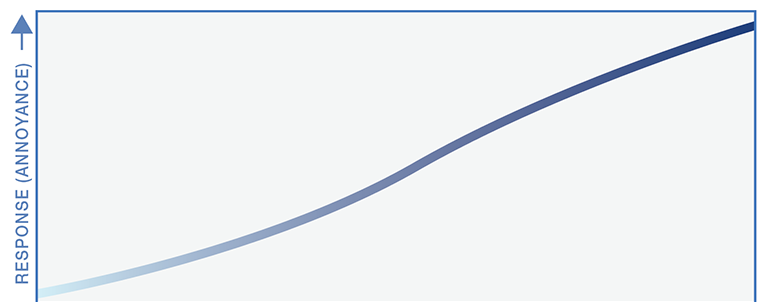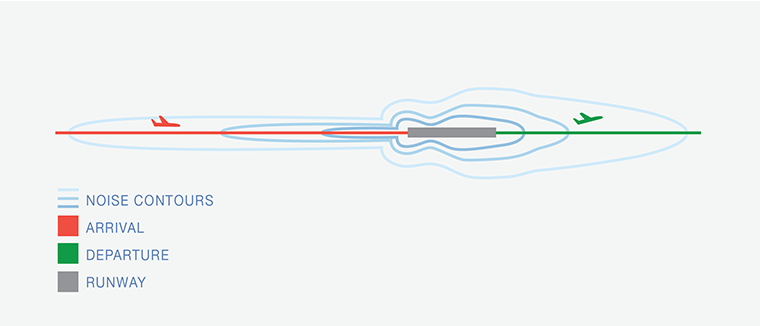Glossary
- Airport Improvement Program (AIP):
- FAA program that provides grants to public agencies for the planning and development of public-use airports that are included in the National Plan of Integrated Airport Systems.
- Average Annual Day:
- Defines a representative 24-hour period across all operational conditions that may occur at an airport over the course of a year.
- Aviation Environmental Design Tool (AEDT):
- An analysis platform that is used around the world to calculate the environmental effects of aviation. It is a robust software system that can generate custom reports on various elements of aircraft performance and is FAA's required environmental analysis tool for regulatory purposes. AEDT can compute fuel consumption, emissions, noise, and air quality consequences. Versions of AEDT are used by the U.S. government for domestic aviation system planning as well as domestic and international aviation environmental policy analysis.
- Aviation Noise Abatement Policy (ANAP):
- FAA's comprehensive aviation noise abatement policy enacted in 1976.
- Aviation Safety and Noise Abatement Act (ASNA):
- Federal statute directing the Federal Government to establish a single system for considering aircraft noise. This act led FAA to the establishment of 14 CFR Part 150.
- Balanced Sampling:
- A statistical method for making a selection from a larger set of choices where the selection shares the same defined characteristics as the whole.
- Confidence Limits:
- Values that define a statistical range of how accurate a set of data can be defined. It is often expressed as the 95% confidence limits. The smaller this range is, the more accurate the result.
- Community Noise Equivalent Level (CNEL):
- Similar to DNL, but applies an additional 4.77dB evening "penalty" from 7 p.m. to 10 p.m. Because of the logarithmic scale, this is equivalent to each evening event being measured as if three daytime events had occurred.
- Code of Federal Regulations (CFR):
- The general and permanent rules published in the Federal Register by the departments and agencies of the Federal Government.
- Decibel (dB):
- A unit used to measure the intensity of a sound. The larger the number is, the louder the sound. It is important to note that if two 50 decibel sounds are heard at the same time, the total sound is not 100 decibels — it is actually 53 decibels. That is because decibels are measured on a logarithmic scale. The decibel is a logarithmic unit used to represent the relationship between a measured sound level and a standard reference value (which is sometimes the lowest audible note of the same frequency). In studying the impact of airport noise on humans, decibels on the "A" weighted scale (dBA) are often used. This scale most closely approximates the relative loudness of sounds in air as perceived by the human ear.
- Day Night Level (DNL):
- A noise metric that reflects a person's cumulative exposure to noise over a 24-hour period. This metric is expressed as the noise level for the average day of the year on the basis of annual aircraft operations. To account for a higher sensitivity to noise exposure at night, DNL calculations include a 10 dB "penalty" for noise events occurring between 10 p.m. and 7 a.m. Because of the logarithmic scale, this is equivalent to each nighttime event being measured as if ten daytime events had occurred. The FAA uses DNL levels to help determine whether homeowners and others impacted by aircraft noise are eligible for federal government-funded efforts to reduce the impact of noise such as the construction of sound barriers or other mitigation efforts. DNL is measured in A-weighted decibels (see Decibels, above).
- Dose-response curve:
- A representation of the statistical relationship, or correlation, between two factors.
-

DOSE (NOISE)
- The FAA has long used a dose-response curve to describe the relationship between cumulative aircraft noise exposure and the percentage of people who are "highly annoyed" by that noise. The dose-response curve is an important tool for informing FAA noise and land use compatibility policies.
- Equivalent Continuous Sound Level (Leq):
- A noise metric that represents the average acoustic energy over a period of time.
- Integrated Noise Model (INM):
- FAA's prior aviation noise modeling tool. INM was retired in 2015, but all functionality is now included in AEDT.
- Logarithm:
- A mathematical expression that allows increasingly large numbers to be expressed more directly. In one common form of the logarithm, or "log," the log of 10 equals 1; the log of 100 equals 2; and the log of 1,000 equals 3. Logarithms of larger numbers can then be plotted graphically and more compactly.
- Maximum Sound Level (Lmax):
- A noise metric that represents the maximum sound level during a period of time.
- National Environmental Policy Act (NEPA):
- The U.S. environmental law promoting enhancement of the environment. NEPA was established in January 1970 by the Executive Branch Council on Environmental Quality (CEQ), and FAA's obligations under NEPA are currently defined in FAA Order 1050.1F.
- Noise Contours:
- Lines on a map that depict noise levels in an area. Similar to topographical maps which show lines of common elevation, a noise contour maps shows where common levels of noise occur. The FAA uses noise contours to depict areas around airports experiencing aircraft noise in order to meet its NEPA obligations as well as to inform land use compatibility and noise exposure and mitigation purposes. Noise contours typically shown represent DNL levels of 65, 70 and 75 dBA.
-
Noise Contour Map

- Sound Exposure Level (SEL):
- A noise metric that represents all the acoustic energy of an individual noise event as if that event had occurred within a one-second time period.
Last updated: Tuesday, March 15, 2022
